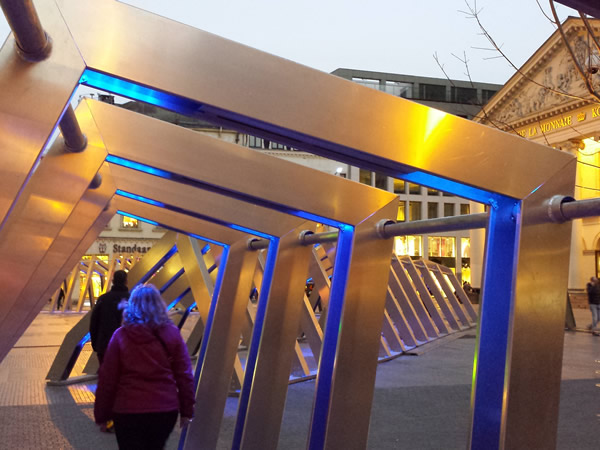Taking an eagle eye view of change making projects across the world you detect a deeper yearning for another kind of city; one that resolutely, yet with imagination and verve, addresses the faultlines and dilemmas of urban change and seeks to bend the market to bigger picture more ethical purposes. R
This is a city that contains the ever-widening gap between haves and have nots, that prefers to open out to the world rather than closing in; that sees the opportunities in the problems so might leads the way in creating the 4th clean, lean, green industrial revolution; a city too that has the courage to deal with creeping corruption and criminality that pervades so much of public life and erodes the civic fabric.
Consider too how civic purpose bursts out in guerrilla gardening schemes or new housing formats that seek to curtain the effects of speculation. Mostly they have novel finance mechanisms often based on new relationships between enlightened partners like the Swiss foundations Abendrot who funded the social enterprise property development Holzmarkt(1) and Maryon, who bought seven large buildings adapting them to cultural use, both in Berlin. With $20 trillion floating across the world looking for a home the aim was to take properties out of the speculative market.
The world hankers after cities of substance that could be pioneers and lead the way and this requires a shift in focus for creativity. Less artistic creativity and more social creativity. One city could be Berlin given its global resonance. Why is this so? Not because it does everything well, there are many things Berliners are critical of. It is because Berlin with its unusual past has a number of features, they include: A history of civic engagement often expressed as resistance and an anarchic streak, a relatively high level of alternative financing means, more resources in public ownership given the West/East divide than comparable global cities, it is a city state with somewhat more power than others. It includes its willingness to use federal laws from Vorkaufsrecht (the right to purchase properties) to Milieuschutz (the protection of the local social and physical environments) with determination to safeguard community balance. Also local laws such as selling public property not to the highest bidder but on the basis of the quality of the proposed development idea are positive.
Another pioneer city of substance is Copenhagen. Here a similar level of determination has seen it reduce its carbon emissions by more than 40 percent since 1990 while its population has grown by 50 percent. It aims to be carbon neutral by 2025 and totally fossil-fuel free by 2050. Studies on becoming completely free of coal, oil, and gas are underway with plans to be released by 2018.
A third could be Amsterdam, who became European Capital of Innovation in 2016. I was chairman of the jury and we were impressed by the city and how as it said ‘was forced to collaborate throughout its history Amsterdam people to prevent flooding, diseases, and other disasters’. The city needed to mobilize the power and creativity of different stakeholders so did not have a top-down approach. In today’s language this is co-creation. This adaptability embedded in its DNA made it flexible in dealing with disruptive technologies and problems. It understands the power of harnessing collective intelligence, social innovations and so has a strong bottom-up culture.
Pakhuis de Zwijger is a good example. Here citizens and the innovation ecosystem can work on new solutions, such as developing a city wide vision for the sharing economy and giving it space and resources to develop, including calls and creating challenges. This is embedded in the idea of seeing the city as a living lab to test, copy or scale up solutions. Part of the ecology is rather technology focused Amsterdam Institute for Advanced Metropolitan Solutions dedicated to research and solving complex urban challenges.
Why when these three cities alone contain a vast storehouse of creative solutions do they not all happen in one place. The next step is to draw a precise picture of what this ‘Other City’ could mean in detail, what its regulations and incentives might be and how and where this has been implemented in order to give courage and will to the change makers and to send out a message ‘that it can be done’.

